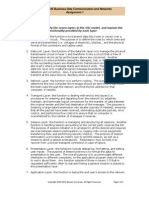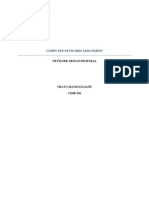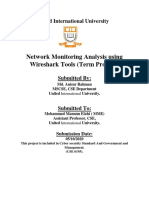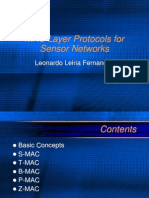Internet Technology
Internet Technology
Uploaded by
Sushant SatyalCopyright:
Available Formats
Internet Technology
Internet Technology
Uploaded by
Sushant SatyalOriginal Description:
Copyright
Available Formats
Share this document
Did you find this document useful?
Is this content inappropriate?
Copyright:
Available Formats
Internet Technology
Internet Technology
Uploaded by
Sushant SatyalCopyright:
Available Formats
Student Id: 11590288
Internet Technology PG
Sushant Satyal
sushantsatyal@gmail.com
Question 1:
Explain the difference between a EUI and a MAC address; give an example of their
practical use.
Answer: MAC address is the media access control address which is the physical address or
unique address assigned to network interfaces for communication in physical network.
Logically they are used in Media Access Protocol sub layer of OSI reference model
(wikipedia). These MAC addresses are represented in binary numbers and can be located in
the network hardware devices. The MAC address is 48 bit or bytes and it cannot be changed
by the user. Each manufacturer of these devices registers and gets the MAC prefixes as per
the guideline of IEEE (The Institute of Electrical and Electronics Engineers). For instance,
the prefixes 00:13:10, 00:25:9C and 68:7F:74 (plus many others) all belong to Linksys
(abouttech).
On the other hand, Extended Unique Identifier (EUI) address is found in the network device
address 6 of the internet protocol IPv6. EUI is represented by two hexadecimal bits in eight
groups and length is represented in 64 bits. The IPV6, 64 bits EUI ensures the host
computers to assign itself 64 bits interface address. Therefore, it is not necessary for the host
computer to be configured manually. This property of EUI addressing makes IPV6 far more
superior than IPV4. The 64 bit EUI address is obtained from 48 bit MAC address by simply
inserting 16 bit hex value FFEE in between two halves of MAC address and by inverting flag
bit (bit 7) of the first octate of the bit frame.
Student Id: 11590288
Internet Technology PG
Sushant Satyal
sushantsatyal@gmail.com
Question 2:
Explain the difference between ICMP and ICMPv6, give some examples of their
practical use.
Answer: ICMP is the Internet Control Message Protocol that is designed to compensate the
lacking features of IPv4, i.e. IPv4 do not have error reporting and the error correcting
mechanism (Forouzan, Introduction To Application Layer, 2013, p. 575). ICMP is a protocol
that is used by network devices to send or report error messages. For instance, when sent
datagram is discarded ICMP sends error message to the application program or the original
source. Moreover, ICMP is also used to manage queries to get information from a router or
another host.
ICMP message format:
Error reporting message
8bits
8 bits
Query message
16 bits
8bits
8 bits
16 bits
Type
Code Checksum
Rest of the header
Type
Code
Checksu
Data Section
m
Identifier
Sequence
Number
There are various types of error
Datamessages
Section send by ICMP while processing datagram and
these data messages contain a data section that have original datagram to give the original
source that receives the error message information about the datagram itself. Some of the
errors messages that are send by ICMP are:
a) Destination unreachable message which may be send while the user want to access
certain webpage but the server is down.
b) Source quench message that informs senders that the datagram has been dropped due to
congestion in the network.
2
Student Id: 11590288
Internet Technology PG
Sushant Satyal
sushantsatyal@gmail.com
c) Redirection message when the sources try to use wrong router to send the message.
d) Parameter problem message when there is some problem in the header of the datagram
or when some problems that cannot be identified.
On the other hand, ICMPv6 is the implementation of the Internet Control Message Protocol
(ICMP) for Internet Protocol version 6 (IPv6) is an integral part of IPv6 and performs error
reporting and diagnostic functions (e.g., ping), and has a framework for extensions to
implement future changes (Wikipedia) . Basically, ICMPv6 performs the same tasks with
more features added to it. (Forouzan, Introduction To Application Layer, 2013) writes that
some protocols that were independent in version 4 are now part of ICMPv6 and some new
messages have been added to make it more useful and ICMP, ARP and IGMP protocols in
version 4 are combined into one single protocol ICMPv6 (p.679).
The ICMPv6 messages can be divided into four types:
a) Error reporting message: It is similar to ICMPv4 that reports destination unreachable,
packet too big, time exceed and parameter problems.
b) Informational message: It is used to check two devices in the network can communicate
with each other or not.
c) Neighbour- discovery message: It determines relationships between neighbouring nodes
and it replaces Address Resolution Protocol (ARP), Internet Control Message Protocol
(ICMP) router discovery, and the ICMP Redirect message used in IPv4. Moreover, it also
provides additional functionality and group-membership messages (networkingnotes.com) .
Student Id: 11590288
Internet Technology PG
Sushant Satyal
sushantsatyal@gmail.com
d) Group membership messages: It is used to convey information about multicast group
membership from nodes to their neighbouring routers which are connected to same link.
Question 3:
Describe the differences between structured and unstructured networks in decentralised
P2P networks? Discuss the advantages and disadvantages of both networks.
Answer: Unstructured networks in decentralized P2P networks do not have a particular
structure or arrangement of nodes. Instead, they are randomly formed on overlay network
design. (Forouzan, Introduction To Application Layer, 2013, p. 1025) writes that A search in
an unstructured P2P is not very efficient because a query to find a file must be flooded
through the network, which produces significant traffic and still the query may not be
resolved. Gnutella is an example of distributed unstructured network. In this network for
instance, if node C want to access a file then it will contact its neighbour whose address is
known to it. Node C sends a query to the neighbour (suppose node K) that includes the
name of a file that it wants to access. If the node K knows the address of a node (suppose
node Z) which has the file, then it sends the response message containing the address of
node Z. But in case when node K does not know the address then it sends the request
from C to all its neighbours and one of the nodes in the network will eventually respond to
the query and C can get access to node X to access the file. One of the major
disadvantages of Gnutella is that Queries flood the network and can cause a large amount of
traffic.
On the other hand, structured P2P networks have predefined or particular network design that
arrange or structure the nodes in the network. They strictly adhere set of rules so that the
Student Id: 11590288
Internet Technology PG
Sushant Satyal
sushantsatyal@gmail.com
query can be effectively and efficiently resolved. The most common technique used for this
purpose is the Distributed Hash Table (DHT). (Forouzan, Introduction To Application Layer,
2013)
Question 4:
Explain the advantages of verifying the hash function of the bit torrent peer to peer
network.
Answer:
The distributed hash table uses particular or redefined set of rules to select the node among
the sets of nodes (Forouzan, Peer To Peer Paradigm, 2013). The hash function of bit torrent is
a structured peer to peer system. There is information about the index where to find the
resources stored on the other nodes. Therefore, one of the major advantage of hash function
of bit torrent in peer to per networks that each peer has the responsibilities for the range of
data items. Furthermore, in order to avoid flooding overhead problem the hash functions
helps the peers in the network to have a partial knowledge about the whole network due to
which request about the data can be route easily and effectively. In this networking system,
user can download the files from peers in the network where the copy of file is available
without having to download from the main server. Another advantage of hash function of the
bit torrent in peer to peer network is that it helps to easily locate the files without consuming
too much time.
Question 5:
Student Id: 11590288
Internet Technology PG
Sushant Satyal
sushantsatyal@gmail.com
In the client-server paradigm, explain the process of FTP connection control and data
transfer.
Answer:
Client-server paradigm:
Client-server paradigm is the most popular application layer paradigm. Here, the service
provider is an application program called the server process which runs continuously, waiting
for another program called the client process, to make the connection through the internet and
ask for the service (Forouzan, Introduction To Application Layer, 2013). The server processes
must run all the time whereas the client needs to receive service. We will not be able to run
client application in absence of server program or vice versa. Example of client server
Microsoft outlook is a client application running on a personal computer acts as client to the
mail server. One of the major drawbacks of this paradigm communication or data exchange
depends completely upon the server. Therefore, the server should be powerful to handle many
client requests.
Process of FTP connection control:
File transfer control is the protocol used to send and receive file from one host to another. It is
regarded as a secured protocol for transferring files. FTPs client has three components used
in the transferring of file: the user interface, the client control process and the client data
transfer process. The server has two components: the server control process and the server
data transfer process. The control connection is made between the control processes. The data
connection is made between the data transfer process. The control connection uses very
simple rules of communication. We need to transfer only a line of command or a line of
6
Student Id: 11590288
Internet Technology PG
Sushant Satyal
sushantsatyal@gmail.com
response at a time. The data connection, on the other hand, needs more complex rules due to
the variety of data types transferred (Forouzan, Standard Client Server Protocol, 2013)
Question 6:
Explain the difference between persistent and non-persistent connections in the client
server paradigm.
While trying to retrieve objects from web pages from different servers located at different
locations, we can use persistent as well as non-persistent connections in client server
paradigm. When we use non persistent connections, in such case we have to make a new TCP
connection to get/ retrieve the object from the web page. In other words, for each request or
response we need create one TCP connection. During non-persistent connection at first, the
client creates TCP connection and sends the request to the server. Then the server sends the
response and closes the connection. The client reads the data until it finds end of file marker
and finally ends the connection (Forouzan, Standard Client Server Protocols, 2013). In this
system, at most one object is sent over a TCP connection. HTTP version 1.0 uses nonpersistent connection.
Student Id: 11590288
Internet Technology PG
Sushant Satyal
sushantsatyal@gmail.com
Non Persistent Connection (Forouzan, Standard Client Server
Protocols, 2013)
On the other hand, persistent connection is used by HTTP version 1.1 in a default mode.
When we use persistent connections, in such case we can just make a TCP connection and
retrieve all objects. The server leaves the connection open for more requests after sending a
response (Forouzan, Standard Client Server Protocols, 2013). Therefore, subsequent HTTP
messages between same client/server sent over open connection helps to reduces response
Student Id: 11590288
Internet Technology PG
Sushant Satyal
sushantsatyal@gmail.com
time. However, sometimes the server can close the connection in case of time-out or when
client makes the request to close the connection.
Persistent Connection (Forouzan, Standard Client Server Protocols, 2013)
Student Id: 11590288
Internet Technology PG
Sushant Satyal
sushantsatyal@gmail.com
References
(n.d.). Retrieved January 14, 2016, from networkingnotes.com:
http://computernetworkingnotes.com/ipv6-features-concepts-andconfigurations/ipv6-neighbor-discovery.html
abouttech. (n.d.). Retrieved January 13, 2016, from
http://compnetworking.about.com/od/networkprotocols/a/introduction-tomac-addresses.htm
(2013). Introduction To Application Layer. In B. A. Forouzan, Data
Communications And Netowrking (p. 820). MCGrawHill.
(2013). Peer To Peer Paradigm. In B. A. Forouzan, Data Communication And
Networking (p. 2016). McGrawHill.
Forouzan, B. A. (2013). Standard Client Server Protocol. In Data Communications
And Networking (p. 887). McGraw Hill.
(2013). Standard Client Server Protocols. In B. A. Forouzan, Data
Communications And Newtowrking (p. 876). McGrawHill.
wikipedia. (n.d.). Retrieved January 12, 2016, from wikipedia.com:
https://en.wikipedia.org/wiki/MAC_address
Wikipedia. (n.d.). Retrieved January 14, 2016, from Wikipwdia.org:
https://en.wikipedia.org/wiki/Internet_Control_Message_Protocol
Wikipedia. (n.d.). Retrieved Jaunary 14, 2016, from wikipedia.com:
https://en.wikipedia.org/wiki/Internet_Control_Message_Protocol_version_6
10
You might also like
- MCSE Questions and AnswersDocument14 pagesMCSE Questions and Answersnareshgotad65No ratings yet
- CiTRANS 650 U3 TechnicalDocument128 pagesCiTRANS 650 U3 Technicalanrao150% (4)
- 9.3.1.4 Packet Tracer - Skills Integration Challenge Instructions PDFDocument3 pages9.3.1.4 Packet Tracer - Skills Integration Challenge Instructions PDFJaime RicardoNo ratings yet
- Network Engineer Interview QuestionsDocument34 pagesNetwork Engineer Interview QuestionsMir Farhan Ali Abedi100% (5)
- TM 601 Homework Assignment OneDocument4 pagesTM 601 Homework Assignment OneSarab JeetNo ratings yet
- Unit-2 - Network VirtualizationDocument47 pagesUnit-2 - Network VirtualizationamarmudirajNo ratings yet
- NetworksDocument63 pagesNetworksilykillit325No ratings yet
- Asiignment With SolutionDocument56 pagesAsiignment With SolutionmaulikNo ratings yet
- Assignment 1Document5 pagesAssignment 1Parker Bollinger IIINo ratings yet
- Web Technologies Js NotesDocument183 pagesWeb Technologies Js Notespswarupa607No ratings yet
- Computer Networking Refers To Connected Computing Devices 222Document13 pagesComputer Networking Refers To Connected Computing Devices 222RAY COOLNo ratings yet
- CCNA Network Fundamentals Chapter 2 Exam AnswersDocument27 pagesCCNA Network Fundamentals Chapter 2 Exam AnswersSelvir KamberovicNo ratings yet
- Network Support LayersDocument3 pagesNetwork Support LayersAbdelrhman AhmedNo ratings yet
- Technical Interview Questions and AnswerDocument9 pagesTechnical Interview Questions and AnswerBadrinath KadamNo ratings yet
- Assignment 3 - Data CommsDocument15 pagesAssignment 3 - Data CommsEugene Embalzado Jr.No ratings yet
- Lesson ObjectivesDocument5 pagesLesson ObjectivesWinny Shiru MachiraNo ratings yet
- 10ec71 - CCN - Notes PDFDocument127 pages10ec71 - CCN - Notes PDFRashmi Samant100% (2)
- Different Networking Systems Advantages and DisadvantagesDocument71 pagesDifferent Networking Systems Advantages and Disadvantagesshabir AhmadNo ratings yet
- CN 1Document7 pagesCN 1T024KOUSTAV CHATTERJEENo ratings yet
- 10ec71 NotesDocument129 pages10ec71 NotesMSAMHOURINo ratings yet
- Communications Layers SummaryDocument7 pagesCommunications Layers SummaryKarthickmanikandan GNo ratings yet
- Seven Layers of Osi Reference Model-1Document7 pagesSeven Layers of Osi Reference Model-1Hamza ChNo ratings yet
- MCSE Questions and Answers:: 1:: What Is The Use of IGMP Protocol?Document14 pagesMCSE Questions and Answers:: 1:: What Is The Use of IGMP Protocol?Sivaprasad-hunt BeginsNo ratings yet
- FAQ'sDocument24 pagesFAQ'sduvvuruvitNo ratings yet
- What Is The OSI ModelDocument25 pagesWhat Is The OSI Modelgetuchalchisa9No ratings yet
- OSI - TCPIP ModelsDocument9 pagesOSI - TCPIP Modelsjemsson66No ratings yet
- Networking ConceptsDocument40 pagesNetworking Conceptscalligraphy4instagramNo ratings yet
- Mcse QuestionsDocument8 pagesMcse Questionskalpeshrane33No ratings yet
- PDF DocumentDocument5 pagesPDF DocumentBritney PitttersonNo ratings yet
- Computer Networks Assignment: Network Design ProposalDocument14 pagesComputer Networks Assignment: Network Design ProposalThato MathogojaneNo ratings yet
- EthernetDocument5 pagesEthernetRiti NayyarNo ratings yet
- Assignment 1 - Madan Lal Gaire (42662)Document6 pagesAssignment 1 - Madan Lal Gaire (42662)madan GaireNo ratings yet
- TCP IP Vs OSI What's The Difference Between Them FS CommunityDocument7 pagesTCP IP Vs OSI What's The Difference Between Them FS CommunityTefeNo ratings yet
- Network Architectures: Layers of OSI Model and TCP/IP ModelDocument5 pagesNetwork Architectures: Layers of OSI Model and TCP/IP ModelLvly AngelNo ratings yet
- List The Layers of The OSI Model and The TCP/IP Protocol Suite (The Internet Model) - A: The Seven Open Systems Interconnection Layers AreDocument13 pagesList The Layers of The OSI Model and The TCP/IP Protocol Suite (The Internet Model) - A: The Seven Open Systems Interconnection Layers Aremadan GaireNo ratings yet
- Assignment-II: Gagandeep KaurDocument12 pagesAssignment-II: Gagandeep KaurYolomanNo ratings yet
- CCNA Final Exam ReviewerDocument50 pagesCCNA Final Exam ReviewerBdick CruzNo ratings yet
- Extended Essay - IBDocument14 pagesExtended Essay - IBKhalil AlamehNo ratings yet
- Networking Theory (Part 1)Document54 pagesNetworking Theory (Part 1)Irsan EhcNo ratings yet
- International Journal For ResearchDocument8 pagesInternational Journal For ResearchRozy VadgamaNo ratings yet
- Lab-2 Networking Basics: What Is A Network?Document6 pagesLab-2 Networking Basics: What Is A Network?Haidar MalikNo ratings yet
- Computer Networks-NotesDocument41 pagesComputer Networks-NotesAnirban BairagyaNo ratings yet
- Edited Unit 1 CN 4TH SemDocument13 pagesEdited Unit 1 CN 4TH Sempawanchourasia0329No ratings yet
- Seven Layers of OSI ModelDocument6 pagesSeven Layers of OSI ModelHasibul HasanNo ratings yet
- Web Engineering 7Document20 pagesWeb Engineering 7HaRis RehanNo ratings yet
- CCNA Summer Traning ReportDocument57 pagesCCNA Summer Traning ReportVishav VermaNo ratings yet
- Osi Model NotesDocument7 pagesOsi Model NotesSuman KumarNo ratings yet
- Capture All HTTP Packets by Using Wireshark and Try To Fetch All HTTP Usernames & PasswordsDocument38 pagesCapture All HTTP Packets by Using Wireshark and Try To Fetch All HTTP Usernames & PasswordsCandy AngelNo ratings yet
- Lec 6Document7 pagesLec 6mariwan zaminNo ratings yet
- Bcs 052 1Document19 pagesBcs 052 1ak9122459681No ratings yet
- ISO/OSI Network ModelDocument19 pagesISO/OSI Network ModelRaazia MirNo ratings yet
- Answer ALL QuestionsDocument25 pagesAnswer ALL Questionsmd_kv_abuNo ratings yet
- Cisco Interview QuestionsDocument8 pagesCisco Interview QuestionsssprudhviNo ratings yet
- Final Assessment CSE 313: Computer Networks Spring-2021Document4 pagesFinal Assessment CSE 313: Computer Networks Spring-2021Al Shahriar HaqueNo ratings yet
- Ccna1 AnswersDocument63 pagesCcna1 AnswersTricia Mutetwa SakarombeNo ratings yet
- 1.0 The OSI (Open Systems Interconnection) ModelDocument5 pages1.0 The OSI (Open Systems Interconnection) Modelvickypatel_63873791100% (1)
- OSI Model (Open Systems Interconnection) : NetworkDocument22 pagesOSI Model (Open Systems Interconnection) : NetworkStephen ChidhandaraNo ratings yet
- A Technical Guide To IPSec Virtual Private NetworksDocument348 pagesA Technical Guide To IPSec Virtual Private NetworksRet SecNo ratings yet
- Network Monitoring Analysis Using Wireshark Tools (Term Project)Document19 pagesNetwork Monitoring Analysis Using Wireshark Tools (Term Project)Md. Anisur RahmanNo ratings yet
- Cisco Certified Network Associate (CCNA) and Cisco Certified Network Professional (CCNP): Mastering Network Automation and Programmability Study GuideFrom EverandCisco Certified Network Associate (CCNA) and Cisco Certified Network Professional (CCNP): Mastering Network Automation and Programmability Study GuideNo ratings yet
- Introduction to Internet & Web Technology: Internet & Web TechnologyFrom EverandIntroduction to Internet & Web Technology: Internet & Web TechnologyNo ratings yet
- Networking Programming with C++: Build Efficient Communication SystemsFrom EverandNetworking Programming with C++: Build Efficient Communication SystemsNo ratings yet
- Hacking Network Protocols: Unlocking the Secrets of Network Protocol AnalysisFrom EverandHacking Network Protocols: Unlocking the Secrets of Network Protocol AnalysisNo ratings yet
- Post Earthquake Impact On Nepalese Film Industry: Mark Only One OvalDocument3 pagesPost Earthquake Impact On Nepalese Film Industry: Mark Only One OvalSushant SatyalNo ratings yet
- Redmond Economic IntegrationDocument140 pagesRedmond Economic IntegrationSushant SatyalNo ratings yet
- Challanges of Economic Development of NepalDocument4 pagesChallanges of Economic Development of NepalSushant SatyalNo ratings yet
- Economics NotesDocument3 pagesEconomics NotesSushant SatyalNo ratings yet
- ScarcityDocument1 pageScarcitySushant SatyalNo ratings yet
- GBRW SME Banking (Key Principles)Document9 pagesGBRW SME Banking (Key Principles)Sushant SatyalNo ratings yet
- Circular Flow PPDocument19 pagesCircular Flow PPSushant SatyalNo ratings yet
- BDCDocument6 pagesBDCSushant SatyalNo ratings yet
- Lab Guide Training v2.0 PDFDocument36 pagesLab Guide Training v2.0 PDFabijith13No ratings yet
- Https - ConfigDocument17 pagesHttps - Configaravindsivan92No ratings yet
- JCVDocument241 pagesJCV200904608No ratings yet
- MAC Layer Protocols For Sensor Networks: Leonardo Leiria FernandesDocument29 pagesMAC Layer Protocols For Sensor Networks: Leonardo Leiria FernandesSrinivas GopisettiNo ratings yet
- Ds 3e0318pDocument2 pagesDs 3e0318pwilliam HurtadoNo ratings yet
- AlohaDocument4 pagesAlohaRajjjjeshNo ratings yet
- CNS BitsDocument3 pagesCNS BitsGAJULA ANANDPRAVEENKUMARNo ratings yet
- ARQDocument6 pagesARQamukhopadhyayNo ratings yet
- Cellusys Protect v1.0Document4 pagesCellusys Protect v1.0Amine ElmekkiNo ratings yet
- CCNA 1 v51 Chapter 6 PT Practice Skills Assessment Packet TracerDocument13 pagesCCNA 1 v51 Chapter 6 PT Practice Skills Assessment Packet TracerCz Tay100% (1)
- BCI IEC60870-5-104 enDocument74 pagesBCI IEC60870-5-104 enT Dung LuNo ratings yet
- User Manual: Redundancy Configuration Industrial ETHERNET (Gigabit) Switch RS20/RS30/RS40, MS20/MS30, OCTOPUSDocument88 pagesUser Manual: Redundancy Configuration Industrial ETHERNET (Gigabit) Switch RS20/RS30/RS40, MS20/MS30, OCTOPUSAbdelali KhalilNo ratings yet
- Is Called A Protocol.: Protocol Is A Standard Procedure and Format That Two Data Communication DevicesDocument7 pagesIs Called A Protocol.: Protocol Is A Standard Procedure and Format That Two Data Communication DevicesHeta DesaiNo ratings yet
- Wireless Lab ManualDocument20 pagesWireless Lab ManualAshutosh GuptaNo ratings yet
- Basic Network TroubleshootingDocument9 pagesBasic Network TroubleshootingNeeraj Mishra50% (2)
- 03 - iewb-rs-vol1.v4.1.BGPDocument130 pages03 - iewb-rs-vol1.v4.1.BGPJuanan PalmerNo ratings yet
- Listado Puertos TCP UdpDocument26 pagesListado Puertos TCP Udpelio320No ratings yet
- Lab:BGP-II TaskDocument10 pagesLab:BGP-II TasksugapriyaNo ratings yet
- 4a-Esp8266 at Instruction Set en PDFDocument68 pages4a-Esp8266 at Instruction Set en PDFOlasehinde Daniel OluwabunmiNo ratings yet
- HP A-Series (H3C) BGP Configuration Basic ExamplesDocument10 pagesHP A-Series (H3C) BGP Configuration Basic Exampleschandrashekar_ganesanNo ratings yet
- Cisco SLM2008 8-Port Gigabit Smart Switch: PD/AC Power Cisco Small Business Smart SwitchesDocument4 pagesCisco SLM2008 8-Port Gigabit Smart Switch: PD/AC Power Cisco Small Business Smart SwitchestalibanindonesiaNo ratings yet
- ATS9900 V100R006C00 Feature List FTDocument14 pagesATS9900 V100R006C00 Feature List FTaranibarmNo ratings yet
- Protocol Description Ipx / SPX (Nwlink)Document2 pagesProtocol Description Ipx / SPX (Nwlink)KaSaEl7No ratings yet
- Oxo10.3 SD Voipservices 8al91205usac 1 enDocument151 pagesOxo10.3 SD Voipservices 8al91205usac 1 enMax IvanNo ratings yet
- KSS ConfigurationDocument2 pagesKSS ConfigurationEaster HarecatNo ratings yet
- Laporan Praktik Industri Perencanaan Dan Perancangan Program PLC Siemens S7-200 Menggunakan Software Step-7 Microwin Smart Di PT Sutanto Arifchandra Electronic PDFDocument1,367 pagesLaporan Praktik Industri Perencanaan Dan Perancangan Program PLC Siemens S7-200 Menggunakan Software Step-7 Microwin Smart Di PT Sutanto Arifchandra Electronic PDFAde SupriantoNo ratings yet
- Pa 3200 SeriesDocument2 pagesPa 3200 SeriesElie WinsbacherNo ratings yet

































































































